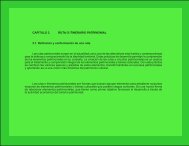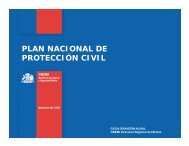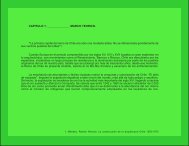LIBRO 47 DELANTE - LEU - Universidad del Bío-Bío
LIBRO 47 DELANTE - LEU - Universidad del Bío-Bío
LIBRO 47 DELANTE - LEU - Universidad del Bío-Bío
You also want an ePaper? Increase the reach of your titles
YUMPU automatically turns print PDFs into web optimized ePapers that Google loves.
96<br />
cluster within space, either due to formal<br />
development processes or informal<br />
means. By methodically reducing the<br />
scale of analysis, it is possible to detect<br />
local-level differences in population characteristics.<br />
Conclusion and Discussion<br />
The research presented in this paper supports<br />
the hypothesis that the nature of<br />
segregation in Lima is such that social<br />
groups are fragmented within the broader<br />
fabric of urban space. At the metropolitan<br />
level, empirical segregation values are relatively<br />
low as compared to other world<br />
cities; however, segregation values are<br />
quite high at smaller spatial scales with<br />
pockets of fragmentation or segregation<br />
visible across the region. By reducing the<br />
scale of analysis, using multi-group measures,<br />
and including social interaction<br />
across space, segregation is indeed evident<br />
across the metropolitan region.<br />
The methodology for analysis presented<br />
here allows for complex data sources to<br />
be integrated easily within a GIS-based<br />
environment. This integration allows for<br />
the analysis of segregation using both<br />
statistical and visual methods, available<br />
within commonly available GIS software.<br />
Additionally, results of segregation analyses<br />
can be linked directly to statistical<br />
software for further analysis. It is hoped<br />
that this tool can be used to further measure<br />
segregation in other Latin American<br />
cities and empirically test common theories<br />
of urban development.<br />
References<br />
• Apparicio, Phillipe. 2000. “Les indices<br />
de ségregation résidentielle: Un outil<br />
intégré dans un systéme dínformation<br />
géographique.” Cybergéo, revue européene<br />
de géographie 134.<br />
• Fischer, Claude S., Gretchen Stockmayer,<br />
Jon Stiles, and Michael Hout.<br />
2004. “Distinguishing the geographic<br />
levels and social dimensions of u.S.<br />
Metropolitan segregation, 1960-2000.”<br />
Demography 41:37-59.<br />
• Giddens, Anthony. 1984. The constitu-<br />
tion of society: Outline of the theory of<br />
structuration. Berkeley: University of<br />
California Press.<br />
• Grannis, R. 2002. “Discussion: Segregation<br />
indices and their functional inputs.”<br />
Sociological Methodology<br />
32:69-84.<br />
• Luco, Camilo Arriagada and Jorge Rodríguez<br />
Vignoli. 2003. “Segregación residencial<br />
en áreas metropolitanas de<br />
américa latina: Magnitud, características,<br />
evolución e implicaciones de política.”<br />
Centro Latinoamericano y Caribeño<br />
de Demografía (CELADE)-División<br />
de Población, Santiago, Chile.<br />
• Massey, Douglas S. and Nancy A. Denton.<br />
1988. “The dimensions of residential<br />
segregation.” Social Forces<br />
67:281-315.<br />
• Peters, Paul A. and Emily H. Skop.<br />
2005. “The geography of poverty and<br />
segregation in metropolitan Lima, Peru.”<br />
PRC Working Paper 04-05-13.<br />
• Reardon, S. F. and G. Firebaugh. 2002.<br />
“Measures of multigroup segregation.”<br />
Sociological Methodology 32:33-67.<br />
• Reardon, Sean F. and David O’Sullivan.<br />
2004. “Measures of spatial segregation.”<br />
Sociological Methodology<br />
34:121-162.<br />
• Sabatini, Francisco. 2003. “La segregación<br />
social <strong>del</strong> espacio en las ciudades<br />
de américa latina.” Serie Azul 35.<br />
• Schnell, Izhak. 2002. “Segregation in<br />
everyday life spaces: A conceptual<br />
mo<strong>del</strong>.” Pp. 39-65 in Studies in segregation<br />
and desegregation, edited by I.<br />
Schnell and W. Ostendorf. Burlington,<br />
VT: Ashgate Publishing Company.<br />
• Schnell, Izhak and Yoav Benjamini.<br />
2001. “The sociospatial isolation of<br />
agents in everyday life spaces as an<br />
aspect of segregation.” Annals of the<br />
Association of American Geographers<br />
91:622-636.<br />
• Wong, David W.S. 1993. “Spatial indices<br />
of segregation.” Urban Studies<br />
30:559-572.<br />
• 2002. “Mo<strong>del</strong>ling local segregation: A<br />
spatial interaction approach.” Geographical<br />
& Environmental Mo<strong>del</strong>ling<br />
6:81-97.<br />
• 2003a. “A comparison of traditional<br />
and spatial mesaures of segregation:<br />
Some empirical findings.” in Muticultural<br />
geographies: The changing racial/ethnic<br />
patterns of the United States,<br />
edited by F. M. Margai. Binghampton,<br />
NY: Global Academic Publishers.<br />
• 2003b. “Implementing spatial segregation<br />
measures in GIS.” Computers, Environment<br />
and Urban Systems 27:53-<br />
70.<br />
Wong, David W.S. and W. K. Chong.<br />
1998. “Using spatial segregation measures<br />
in GIS and statistical mo<strong>del</strong>ing<br />
packages.” Urban Geography 19:<strong>47</strong>7-<br />
485.







